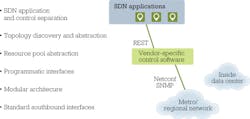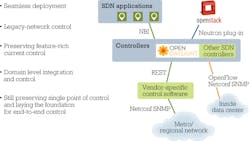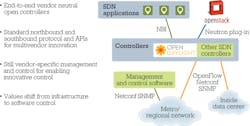Open networks will be the key to meeting future requirements.
Driving new opportunities in the cloud
By MIKE MARSHALL
The fundamental nature of data-center computing is rapidly changing. Conventional data centers built to support traditional client-server applications are giving way to virtual IT environments that enable dynamic workloads, mobile applications, and on-demand services. Enterprises are leveraging server virtualization and cloud provider services to boost IT agility; support Big Data, high performance computing, and analytics; and improve data-center economics.
Globally, organizations are turning to the cloud to improve service velocity and contain costs. According to the Cisco Visual Networking Index (VNI), 85% of new software is now being built for the cloud. By 2018, 76% of data-center traffic will come from the cloud and three out of four data-center workloads will be processed in the cloud.
With game-changing applications that include cloud computing, mobility, video, and Big Data requiring support of non-stop - and costly - bandwidth demands, cloud and service providers are driving toward a new business model. They seek to reduce skyrocketing operational costs and become more efficient, while continuing to ensure real time response and customer loyalty. To accomplish this new model, cloud providers are migrating to open networks, inside and outside the data center.
What makes a network "open"?
Open networks sharply contrast with "vendor lock-in" or proprietary approaches. Predictable, flexible, high performance cloud connectivity is critical to delivering a superior user experience and maintaining a competitive advantage. Open networks enable providers to leverage new open-source technologies and innovations as well as drive new initiatives such as software-defined networking (SDN) and network functions virtualization (NFV) to add programmability, automation, and service agility with new levels of control and orchestration.
Yet defining an open network isn't easy; it can take many forms. Some have defined open networking as the use of fully interoperable elements within the network. However, automation and programmability - achieved only through open APIs and standard protocol-based approaches - are vital open-network functions that significantly reduce opex and capex and improve efficiency. Open source, and specifically Linux-based, approaches with open and standard integration points are driving innovation toward such automation of network control.
SDN's role
SDN specifically represents a significant and exciting transformation for cloud-and service-provider networks. With it comes the promise of openness that fosters network flexibility, automation, programmability, and virtualization. Additionally, SDN creates a new approach to building networks that enables cloud and service providers to refine their operational models to grow their businesses quickly and profitably.
SDN is being phased into provider networks within platforms deployed inside and outside the data center (see Figures 1, 2, and 3). Transport SDN, in particular, needs this evolutionary approach to enable use cases today with the ability to evolve toward an open, multivendor, multi-domain model in the future.
This SDN phased-in approach enables cloud and service providers to fully monetize their investments in futureproof network platforms with near-term SDN use cases. In the short term, those use cases can include bandwidth on demand and overlay virtualized network functions (VNFs); in the longer term, they can integrate more open and standard SDN components as they evolve.
These SDN deployments are expected to increase rapidly - Infonetics Research predicts that the data-center SDN market could hit $18 billion by 2018. Leading this movement to open networks are the largest cloud providers, who are already reaping the benefits of this shift.
For example, Facebook's Open Compute Project was formed to develop its own custom servers, power supplies, server racks, and battery backup systems for total control of their data centers. The results of the initiative have been positive: The Open Compute Project has driven down costs through reduced power demands and significantly improved efficiency. Further, Facebook is leveraging its Open Compute Project to create a dialogue with other companies to "collectively develop the most efficient computing infrastructure possible."
Amazon Web Services (AWS) offers developers an in-the-cloud infrastructure based on Amazon's own open backend technology platform, "which developers can use to enable virtually any type of business." With AWS, users have access to resources when their businesses need them and can achieve faster results, while incurring lower costs.
Proprietary approaches often do not offer flexibility, are expensive and/or promote vendor lock-in, and will not fit into an open network. As a result, cloud and service providers leading the open-network movement increasingly discount proprietary strategies.
With this trend in mind, organizations such as the OpenDaylight Project, Open Networking Foundation (ONF), Optical Internetworking Forum (OIF), and Open Networking Lab have tackled open standards and the creation of a collaborative environment for open source networking innovations. OpenDaylight's mission is to establish "a combination of open community developers and open source code and project governance that guarantees an open, community decision making process on business and technical issues." Earlier this year, an OpenDaylight Project survey found that 95% of respondents want open source SDN and NFV deployments.
The ONF is a user-driven organization dedicated to the promotion and adoption of SDN through open standards development. Executive Director Dan Pitt recently predicted that in 2015 open source software will become the new norm for network standards and that network operators will demand open SDN, not vendor SDN.
The Open Networking Lab, founded by SDN technologists from Stanford University and UC Berkeley, has created its own open source SDN. The recently launched open source SDN Open Network Operating System (ONOS) is designed to enable agile service creation and deployment at scale on any hardware.
And finally, the OIF is also taking a lead role in helping to define the application of SDN principles to transport networks. Clearly, there's great momentum within standards bodies and open software communities to make huge strides in 2015.
What's the point?
What are the benefits of open networks for cloud and service providers? There are numerous advantages, including network automation and programmability, with additional benefits continuing to evolve.
Importantly, open networks drive seamless integration of best of breed open source and vendor-specific components via a standard means of interoperation and management. Centralized control with automation also removes inefficient, costly, and error-prone manual operations. Programmability enables providers to create self-service models that grant critical capabilities such as bandwidth on demand and provisioning to enterprise customers, who can enjoy a "pay for what you need, when you need it" opportunity.
In addition, network-wide service orchestration engines enabled through open software provide the ability to provision end-to-end services (such as Carrier Ethernet and wavelengths on demand). Open REST APIs deliver the flexibility to integrate these orchestration engines with various SDN products. Open APIs within network elements have created new opportunities, including cloud exchanges, providing service and collocation providers with the ability to empower enterprises with access to multiple cloud providers through a single self-service portal.
Moreover, opex and capex costs are significantly reduced as providers shift to an open ecosystem of commodity, off the shelf hardware and innovative software. Providers who have not yet deployed SDN within open platforms are already using multivendor models with standards-based integration points to avoid being locked into proprietary approaches and strategies.
Vendors have no choice but to be active participants in this movement to open networking. Openness must happen at various integration points, including hardware platforms, operating systems, and the decoupling of control and data planes. That means literally opening up the stack. SDN and NFV have the potential to be the pathway to open networking. While SDN has not yet been deployed widely at the transport level, the evolution is coming soon, with proof of concept examples to be tested in 2015.
With open source components available to developers at every level of the stack, vendors today certainly can create open networking platforms. But completely abandoning current equipment, installations, and investments is not practical nor does it make business sense. Cloud providers want solutions, not boxes - and solutions that drive their top and bottom lines. Vendors must focus on areas where they can innovate and solve provider pain points, building on open APIs and standard protocols for seamless integration. Making those decisions on when and where to innovate presents a very complex challenge for vendors, but it's one that has to be addressed.
MIKE MARSHALL is director, SDN & NMS product management at BTI Systems.



